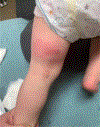Management and Prevention of Staphylococcus aureus Infections in Children
- PMID: 35168715
- PMCID: PMC9901217
- DOI: 10.1016/j.idc.2021.11.006
Management and Prevention of Staphylococcus aureus Infections in Children
Abstract
Staphylococcus aureus is a common skin commensal with the potential to cause severe infections resulting in significant morbidity and mortality. Up to 30% of individuals are colonized with S aureus, though infection typically does not occur without skin barrier disruption. Infection management includes promptly addressing the source of infection, including sites of metastatic infection, and initiation of effective antibiotics, which should be selected based on local antibiotic susceptibility patterns. Given that S aureus colonization is a risk factor for infection, preventive strategies are aimed at optimizing hygiene measures and decolonization regimens for outpatients and critically ill children with prolonged hospitalizations.
Keywords: Bacteremia; Colonization; Decolonization; Meningitis; Osteomyelitis; Pneumonia; Skin infection; Staphylococcus aureus.
Copyright © 2021 Elsevier Inc. All rights reserved.
Conflict of interest statement
Disclosure This work was supported in part by a grant from the National Institutes of Health (NIH)/Eunice Kennedy Shriver National Institute of Child Health and Human Development (OT2-HD107559) and the Agency for Healthcare Research and Quality (AHRQ, R01-HS024269). The content is solely the responsibility of the authors and does not necessarily represent the official views of the NIH or AHRQ. ICK reports consulting fees from IPEC Experts, LLC. C.M. Kao reports clinical trials research funding from Pfizer and Merck. S.A. Fritz reports clinical trials research funding from Merck.
Figures





References
-
- Lowy FD, Staphylococcus aureus infections. N Engl J Med, 1998. 339(8): p. 520–32. - PubMed
-
- Akinboyo IC, et al., Burden of healthcare-associated infections among hospitalized children within community hospitals participating in an infection control network. Infect Control Hosp Epidemiol, 2021: p. 1–3. - PubMed
-
- Herold BC, et al., Community-acquired methicillin-resistant Staphylococcus aureus in children with no identified predisposing risk. Jama, 1998. 279(8): p. 593–8. - PubMed
Publication types
MeSH terms
Substances
Grants and funding
LinkOut - more resources
Full Text Sources
Medical

